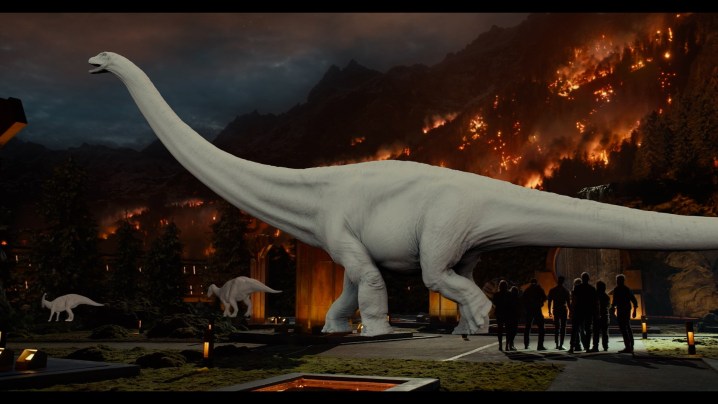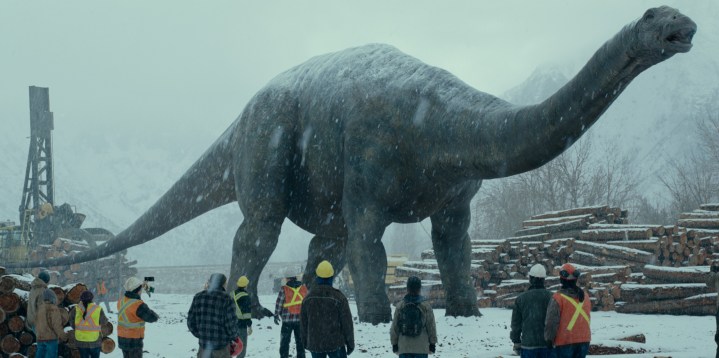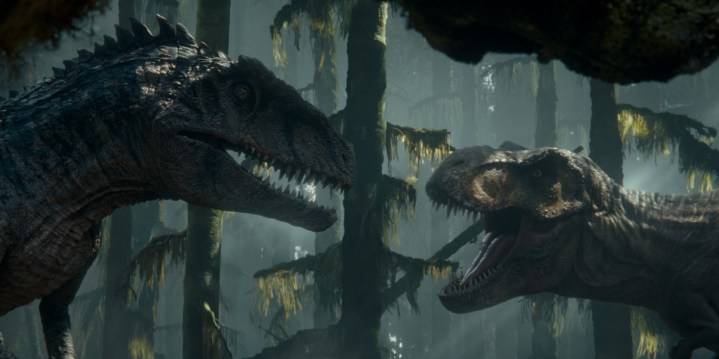The Jurassic World trilogy concluded in epic, roaring fashion with Jurassic World Dominion, which brought the franchise full circle in multiple ways. Not only did Dominion bring back Jurassic World director Colin Trevorrow behind the camera, but it also reunited the modern trilogy’s stars, Chris Pratt and Bryce Dallas Howard, with those of the original Jurassic Park: Sam Neill, Laura Dern, and Jeff Goldblum.
Dominion also featured the return of some popular dinosaurs from the original trilogy, as well as the introduction of a few amazing — and terrifying — new dinosaurs, too. Blending all of these fresh and familiar elements together was no small feat. Digital Trends spoke to the film’s visual effects supervisor, Academy Award nominee David Vickery, about the “digital paleontology” his team performed while revisiting the franchise’s past in Jurassic World Dominion.

Digital Trends: Dominion introduced some new dinosaurs to the mix. What kind of research goes into bringing new dinosaurs into the franchise? Do you have paleontologists you consult?
David Vickery: Absolutely. We had a new consultant paleontologist on this one. We worked with Jack Horner previously, and Steve L. Brusatte came in on Dominion. He was amazing. It’s awesome to work with somebody who absolutely, 100% understands dinosaurs and has such a passion for them.
Basically, we always start with science. It’s pretty much a golden rule in visual effects: You don’t try to make stuff up unless it absolutely doesn’t exist. We looked at holotype specimens of dinosaurs’ skeletons to understand how muscles attach in different positions and where there are pressure points in bones, and that helps you understand how dinosaurs move and walk.
Steve would advise us on different poses for creatures, too. Theropods are often depicted as standing quite upright, but he told us they would have walked a little more planked out. Some of the vertebrae in the upper part of their tails were fused, so they would often have much stiffer tails than they’ve been depicted with. So that’s where we start with everything. We’re making a film, though, so we’re trying to entertain people and create something as visually interesting as possible, too. So there’s always a bit of deviation from science.


The films do a wonderful job of making the dinosaurs expressive. The raptor Blue, for example, conveys a lot in its scenes. How do you approach making dinosaurs fully realized characters in the story?
That’s awesome to hear. Micro-movements help us express different emotions really well. You understand what your dog’s thinking, for example. When a dog cocks its head in a certain way, you know it’s being inquisitive. But we can also fall back on traditional animation techniques, like manipulating the line of the brow or the angle of the pupil to tell you something is angry or happy. You can turn the corners of the mouth up slightly, and the creature looks happy. And if you turn it down, it looks sad. It’s a real skill that the animators have developed over many years.
How do you make a dinosaur say no? How do you make a dinosaur look angry? It’s all about pose and silhouette and form. One of the amazing things the animators will do sometimes is to perform the scenes themselves. When they’re looking for reference, our animation submissions at [VFX company Industrial Light & Magic] will have a picture of the dinosaur animation and a picture of the animator in their bedroom, moving around and actually blocking the sequence out themselves. And if you believe the person and their movement, you’re going to believe the creature. We have a lot of fun with it, that’s for sure.

Three of the new dinosaurs in Dominion really stood out, and I’d like to know more about their backgrounds. First up, the Pyroraptor — the feathered dinosaur that chases Owen and Claire on the ice and swims underneath it. Was that one tricky to create?
It was! I read the script and it was like the visual effects gauntlet was laid down by Colin. It jumped off the page as being a real challenge for us and I was keen to get my teeth into it. I think [the script] said, “The pyroraptor bursts from the ice, landing as snow crystals form on its feathers …,” and I was like, “Wow, that’s an amazing image. How are we going to do that?” We wrote a new feather system at ILM in [3D animation software] Houdini that allowed us much more creative control and flexibility in how we placed the feathers on the dinosaur and created different types of feathers, like the primary feathers on the wing, the feathers on the back of its head, or the softer, downier feathers on its belly.
That system allowed the animators and the simulation artists to run simulations for the wind, the water, and the feathers with the snow and the ice. It could all be run in the same piece of software, so when the wind in the simulation blows, it ruffles the feathers and knocks the snow off the tops of them, and so on. It gave a coherence to those simulations which lent a real air of believability to them.

Another one that stood out is the Therizinosaurus — the one with the long arms and massive claws that hunts Bryce Dallas Howard’s character through the forest. What went into bringing that one to life?
It might sound like we’re taking it too far, but these creatures are all characters and they have to have a personality, so the animators want to know what’s motivating the creature, just like an actor. They need inspiration for how to direct them and how to move them.
In the case of the Therizinosaurus, it had cataracted eyes, so it was partially blind. Colin and I discussed the idea of it using clicking noises which would echo through the forest and give Skywalker [Sound] something really interesting to work with. It also let us give it these birdlike movements and chatter the lower jaw while it searches in an almost-blind way around its environment. It creates this tense cat-and-mouse chase between Therizinosaurus and Bryce. And it was an exercise in restraint on the animators’ part to use as little movement as possible to sell that tension. I think they pulled it off beautifully.

What about the film’s big bad, the Giganotosaurus? What went into giving it a unique look and making it feel like a dinosaur that can go toe-to-toe with Tyrannosaurus Rex?
The tricky thing about the Giganotosaurus was that you want to create something that’s bigger and meaner than a T-Rex, because let’s face it: The T-Rex is the hero of this movie at this point. Bryce and Chris can step aside, because the T-Rex is why we’re coming to see the movie. The Gig needed to be a little bigger, a little badder, and a little scarier. It’s spiky and mean-looking, and it’s got a scar on its face. But at the same time, there’s a really fine line between a dinosaur and a dragon.
We went through so many subtle tweaks and designs, like changing the length of the spines that run along its back and head. We’d show Colin art at various points and he’d be like, “It looks like a dragon. This isn’t Game of Thrones.” So trying to create something that felt mean and fantastic, but not turning it into a monster, was a real challenge for us.

We’ve talked about dinosaurs a lot, but what about the film’s giant locusts? What went into creating the locusts, and later on, destroying them?
Aside from the dinosaurs, the locusts were my favorite thing in the film. A one-foot locust is pretty horrifying, but a swarm of them, bigger than any dinosaur can ever be, is one of the few things more threatening than a dinosaur. We had a little animatronic version of the locust, without any legs on it or wings. When Sam is holding the locust in the lab, we added digital wings and legs to lend a bit more life to it. But there are literally millions of locusts in the movie that were digitally created. We created huge simulations in Houdini using real locust swarms as reference, but also bird murmurations and the flow and fluctuation when large flocks of starlings murmurate in the sky.
But one of the real challenges for us was destroying them. We had an amazing set built on a stage at Pinewood Studios for the lab that appears in the film. At the end of the movie, Lewis Dodgson (Campbell Scott) torches it and all the locusts inside it. We built a rig to burn the actual set. [Special effects supervisor] Paul Corbould and his team built a kind of “flaming car wash,” as we called it, with propane jets rigged on a big metal gantry that traveled the length of the set. We rigged eight different cameras into the set and everybody left the building, and then they torched the entire set while we filmed it.

Wow. You only get one try with something like that!
Yeah, you only get one go at it. Back at ILM, we were able to render simulations of burning, murmurating locusts and integrate them with the practical fire, adding elements of digital glass and smoke and embers in amongst all of the practical fire that was captured on set. It was a really great example of collaborating with the special effects team in enhancing the photography.
You also brought back a lot of dinosaurs from the original Jurassic Park for this one. Visual effects have changed a lot since 1993, so how did you approach bringing these elements back with modern techniques?
With the T-Rex, we tried to restore her to her former glory. She’s evolved over the years. She’s more emaciated and aged in Fallen Kingdom. And now she’s fending for herself in the wild. For Dominion, we went into the ILM archives and looked at the image files from 1990 to 1993 and unarchived them. We got the model of the original T-Rex from Jurassic Park, which was a pretty cool thing to see as a visual effects artist. So we added all of that to our existing model, which has more detail, higher fidelity, and higher resolution. Her shape had changed subtly since then, like how sunken her eye sockets were now, for example.
We did something we called “digital paleontology” because we were digging up the bones of the past and putting new flesh on them. We wanted to pay service to the fan base, and show them that we do listen. They wanted to see T-Rex restored to her former glory. Referencing all of Stan Winston’s beautiful photography and the beautiful animatronics and textures from those original films was a really wonderful process to go through.

Is there a scene from the film you’re particularly proud of?
It’s a group of shots, so it’s cheating a little. I really enjoyed working with some of the stock footage we created for the film. Colin wanted to use stock footage to show that it’s not just this group of characters who have come across dinosaurs, but people all around the world, using cameras, smartphones, and different technologies, witnessing them in the wild. There’s a shot inside a car on a street at night with some Gallimimus in the fog, running toward the headlights of the car. That’s actually my car. I shot that with my iPhone. That’s a real favorite of mine.
And the last shot in the movie is a sunset, with this huge, red sky and a big, bright sun in the middle of the frame. There are silhouettes of dinosaurs walking across the shot, and it’s such a glorious, beautiful image. It was based on a piece of stock footage Colin found. In the end, it became a completely digital shot, but it’s such a beautiful homage to everything about the Jurassic franchise.
Directed by Colin Trevorrow, Jurassic World Dominion is available now on 4K, Blu-ray, and Digital On-Demand in a special extended edition.



